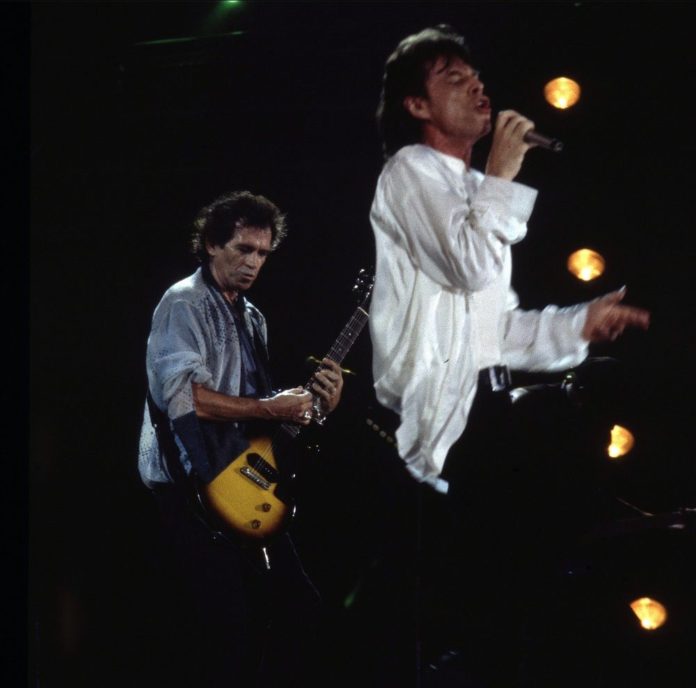INDIO, Calif. – Americans got hooked on all kinds of nasty things in the 20th century, but nobody guessed that nostalgia-tripping would be the hardest habit to kick. Now, as proud citizens of the information age, our unprecedented access to the past comes with the worry that we might be numbing ourselves to the wonders of the present. If your heart droops whenever you spot a prematurely middle-aged kid wearing a Led Zeppelin T-shirt, you know this feeling.
Maybe your heart slumped – or bounced – when you heard about Desert Trip, a three-night mega-concert held in California over the weekend, featuring Bob Dylan, the Rolling Stones, Neil Young, Paul McCartney, the Who, and Pink Floyd’s Roger Waters. As rock stars go, these are most of the biggest ones breathing, and many listeners – including the 75,000 in attendance each night at Desert Trip – would probably argue that the music these heavies made during the Vietnam era remains not only unimpeachable but unsurpassable. Here was a chance to measure them against one another – and against our memories.
Has our collective recall have ever felt this total? The further we move into the digital future, the more our history surrounds us. Drop a few keystrokes into a YouTube search bar and you can summon your favorite rock songs, your favorite movie scenes, your favorite television commercials for your favorite childhood breakfast cereals. This magical memory machine isn’t going away anytime soon, so we’d be wise to welcome our past into our present, instead of treating it like some zombie army that keeps chasing us around the neighborhood. In terms of rock ‘n’ roll, the pattern of linear progress – rock to punk to alternative – is officially kaput, and a broader truth is sinking in: All music is contemporary music, so long as someone is listening to it. A song stays alive simply by moving the air.
For three nights at Desert Trip, the air was crowded with familiar melodies and mysterious contradictions. The gathering itself felt like a tacit goodbye to the rock age, as well as a loud consecration of this music’s everlasting life. It also concluded once and for all that a virtuous counter culture can completely transform itself into a money factory. (Word in the parking lot was that the concert’s promoters, who also organize the annual Coachella festival on this site each spring, would gross $160 million across two weekends of Desert Trip, making it the most lucrative music festival of all time.) But in its greatest moments, Desert Trip felt more like a continuity than a conclusion – an opportunity to think about how colossal songs drift through time, and how the human memory is a flexible, living thing.
The weekend’s other most flexible, living thing was Mick Jagger. He and his fellow Stones strutted into their Friday night set with a pledge to never stop (“Start Me Up”), and finished up with a tantrum of insatiability (“(I Can’t Get No) Satisfaction”). Throughout all of this delicious wanting-and-not-getting, Jagger appeared to be made of only lung, ligament and lust. Somehow, he was 73 years old. Meanwhile, guitarists Keith Richards and Ron Wood, and drummer Charlie Watts kept stacking up rude little gestures until they’d built the towering songs that everybody had trekked to the desert to dance to. Their improvisational touch underscored an inside-out mastery of the material: they know these riffs well enough to make it sound like they’re still learning how to play them. In turn, we’re forever learning how to listen. That’s the deal with the Stones, and it’s still a really good one.
We all know Dylan’s deal. He’s increasingly unknowable, his voice has gone totally rotten, and he continues to nourish his legend by refusing to fulfill anyone’s expectations. But he got halfway into the spirit of Desert Trip’s celebratory opening night, performing a handful of tunes that once helped soundtrack a bloom in American consciousness – “Highway 61 Revisited” and “Don’t Think Twice, It’s Alright” and “Masters of War” among them. These songs sounded like they’d barely survived the past 50 years, their lyrics violently clogging in Dylan’s throat as if he were dragging them across the decades right before our very ears.
Behind Dylan and his band, a massive video screen played old footage of train yards, steel foundries, oil derricks – evidence of postwar progress, sepia-toned and pixelated, decayed in two separate eras. This created an especially dizzying time-swirl during “High Water (For Charley Patton),” a cut from 2001 that honors an ancient bluesman with a riff that sounded like it had been directly lifted from a Home Depot commercial. More saving, more doing – could that be the power of Bob Dylan, too? He continues to tour relentlessly, but always withholds so much, and this performance was no exception. Contemplate the enigma or sit back and watch the trains.
There was no ambiguity to McCartney’s marathon performance on Saturday. With old Beatlemania footage frequently flashing on that sprawling video screen, this was a lock step stroll down memory lane, and ultimately, a mass singalong to some of the most generous refrains in circulation. As charming and charitable as ever, McCartney wasn’t giving the people what they wanted – he was giving them what had always been theirs. It isn’t hyperbole to suggest that the Beatles taught the kiddos of modernity how to feel their emotions, let alone how to sing them. It also helps that everyone is born fluent in McCartney’s beautiful nonsense love-language: Obla-di-obla-da, na-na-na-na.
But in all of these sunbeams, there were still shadows of grief. McCartney sang “Here Today” for John Lennon, and “Something” for George Harrison, and “Maybe I’m Amazed” for his late wife, Linda. These memorials surfaced the unspoken tension that coursed through Desert Trip. Who wasn’t here? And who might not be around tomorrow? With David Bowie and Prince leaving us so abruptly earlier this year, it’s difficult not to hear the mortality of our heroes buzzing in the background of our collective consciousness. In that sense, listening to so many era-defining hits effervesce into the nothingness of the California night felt uniquely sobering.
For that reason and so many others, it’s always been perverse to think of rock musicians as gods – yet sonic acts of godly power were in abundance at this festival. They came surging from the hands of Pete Townshend on Sunday night during the Who’s “Can’t Explain” when the guitarist magically funneled the ultra-violence of his solo back into the song’s sturdy riff, creating chaos, then taming it.
But aside from those life-affirming gusts of sound, Townshend was the sole malcontent at the lovefest. When he asked the crowd if they’d come “to watch old people dance,” it wasn’t clear whether he was mocking his flock or himself. Later in the set, he complained about “Stairway to Heaven” stealing airplay from the Who, and even took a jab at his late drummer, the inimitable Keith Moon. Between so many bursts of joyful noise, he seemed inexplicably aggrieved – a god atop Mount Olympus feeling self-conscious about the length of his lightning bolt.
Just in time to lower everyone’s blood-pressure, Roger Waters followed with the festival’s closing set, performing in front of a calming video panorama of glinting stardust and lava-lamp goo – lovely visuals that ran parallel to the liquid pomp of the Pink Floyd songbook.
But deeper into the night, contemporary politics came charging into the frame. During “Pigs (Three Different Ones),” Waters reincarnated one of rock ‘n’ roll’s most iconic stage props, Pink Floyd’s giant inflatable pig, and floated it over the crowd – this time with Donald Trump’s face emblazoned on its haunches. And so our 72-hour respite from 2016 had officially come to an end. It was time to head back into the real America, where an actual flying pig might not even make the evening news.
Come Monday morning, the hangover might have hurt. How had rock ‘n’ roll done so much to change the world without actually saving it? Are those “Masters of War” that Dylan threatened to kill a self-replicating evil that can’t be destroyed? When Neil Young and McCartney teamed up for a duet of Lennon’s “Give Peace a Chance,” were they just sending more hopeless wishes into the wind? Has the menacing weather of “Gimme Shelter” – “Ooooh, a storm is threat’ning/my very life today” – been threatening our very lives every day since Altamont?
Young offered a reconciliation that seemed to be embedded in the sound itself – he pulled songs from the past to animate the present in hopes of protecting the future. His was easily the most righteous and dynamic set at Desert Trip, and when Young and his backing band, Promise of the Real, embarked on a 20-minute quest through 1969’s “Down by the River,” the music exuded an ultra-presence that felt bigger than life.
Other songs from different eras spoke to one another across the years. When Young urged listeners to “Respect Mother Earth and her giving ways/or trade away our children’s days,” from 1990’s “Mother Earth (Natural Anthem),” it only made the journey described in 1971’s “Heart of Gold” feel more urgent. Nobody finds love if there’s no Earth to find it on.
Nostalgia can cloud the mind, but Young had his priorities in the right order. Instead of wondering whether the greatness of rock ‘n’ roll could ever be eclipsed, he was arguing for a world where we’ll get to find out.









